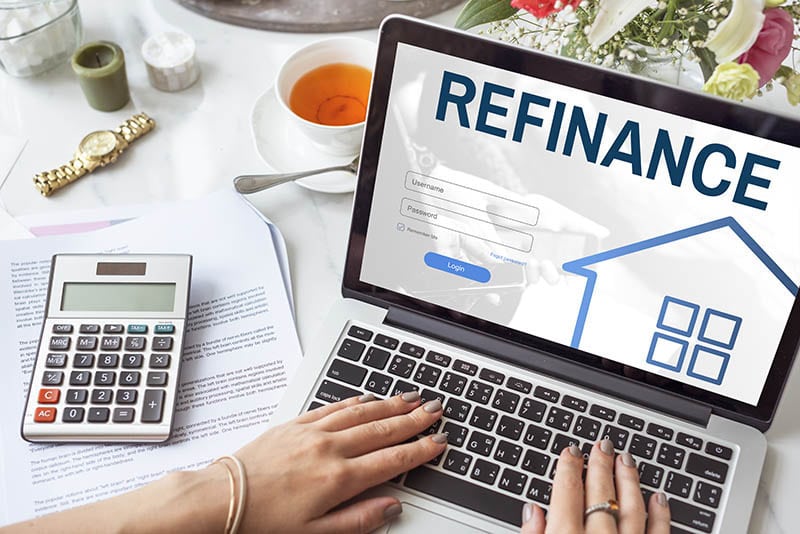What Happens When You Refinance Your Home? Interest & Fees
-
- Last updated:

After you get a mortgage, it won’t be long before you start hearing about refinancing. Banks will start calling and asking whether you are interested in refinancing. Your friends at work will start giving you unsolicited advice about refinancing your house. Suddenly, everyone wants you to redo your mortgage and get a new one. What gives? What happens when you refinance your home? Why do banks allow refinancing?
When you refinance your home, you are trading in your original mortgage for a new one. During the refinancing process, the new bank will pay off your original mortgage and issue you a new one. It is almost an identical process to how a mortgage is first obtained but instead of the homeowner getting a check from the bank for the house, one financial institution receives a check from a second financial institution for the mortgage. But why do banks want to buy and sell your mortgage?

Interest, Fees, and Payoff Times
Some banks have a financial incentive to help you refinance your home. Very few refinancing plans keep your mortgage the same as it was before. Many refinancing options include extended payoff times, lower interest rates, and closing costs or fees. For example, if you originally had a 30-year mortgage that you have been paying on for six years and you refinance back into a fresh 30-year mortgage, you will have to start the repayment clock over again. The monthly costs might be lower, but it will take you thirty more years to finish the loan term. That means your original 30-year mortgage will turn into a 36-year mortgage. That means more interest for the banks over time.
Refinancing can also come with closing costs. Closing costs can be as much as $10,000, and that is straight money that goes into the pockets of brokers, bankers, and agents. For them, that is easy money that is often rolled into the principal. For example, if you are refinancing for a lower interest rate, they might roll in the costs into the new mortgage. If your original principal was $300,000, the new principal might be $315,000. Sometimes, you don’t even notice these subtle changes during the course of the process. Some banks hope you are enamored with lower interest rates enough to gloss over the hefty refinancing costs.
Lastly, refinancing offers some stability for banks that might have a lot of mortgages. If your original bank receives the money for your mortgage from a refinancer, then that loan is paid, and the outstanding risk is eliminated. Mortgages are considered relatively safe by financial institutions, but they will not complain when a mortgage gets paid off by another bank.

A Constructive Example
Say you are a first-time homebuyer. You buy your home for $400,000 at a 4% interest rate. That equates to roughly $1,900 per month. You pay on the loan for five years and eliminate $25,000 in principal. You then decide to refinance. The new terms are 30 years, $385,000 in principal, and 3% interest. That lowers the monthly payment to $1,600 per month, a $300 per month savings. Who gets what in this situation?
| Original Terms | New Terms | |
| Length | 30-year | 30-year |
| Principal | $400,000 | $385,000 |
| Interest Rate | 4% | 3% |
| Monthly Payment | $1,900 | $1,600 |
The Original Mortgage Lender Gets:
- The loan paid off
- Received five years in interest payment
The Refinancer Gets:
- $10,000 in closing costs
- A fresh and safe 30-year mortgage
- Your home as collateral
- 30-years of potential interest payments
The Homeowner Gets:
- $300 per month in savings
- A lower interest rate
- Five extra years in mortgage payments
- $10,000 in increased principal
The homeowner is trading short term savings for a greater long term bill. Even at a lower interest rate, extending a mortgage out over time will lead to higher costs in the end. Many people are more than happy to trade extra payments decades down the road for monthly savings that you can see right now. The banks are happy to shuffle some money around for closing costs or to secure a new income stream.
Should You Refinance?
The choice to refinance your home is a personal one. It makes sense for some people but not for others. If you plan on refinancing your home, be sure to consult multiple banks. Pay attention to closing costs, interest rates, the total cost of the loan, and the time to repay. Extending a mortgage term sounds good in the short term, but it might become a burden down the road if you keep resetting the loan clock back to zero. Some people want monthly savings. Some people want a lower interest rate so they can try and pay off the home faster by putting more into the principal.
Before you refinance, get multiple offers and consider who gets what in the situation. There is no point in refinancing for marginal gains if you have to pay large closing costs or a lot more long-term interest.

Conclusion
Refinancing a home is like taking out a mortgage on your mortgage. It may sound counterintuitive, but there are actually a lot of benefits for the banks in this situation. Homeowners get benefits too, but it is not something that is altruistic that the banks offer. The banks just want to try and make more money off your existing mortgage. Refinancing is common, and it is usually safe and easy to do, but it does come with some costs, terms, and rules that need to be understood before you go into the process.
Featured Image Credit: Rawpixel.com, Shutterstock
Contents

